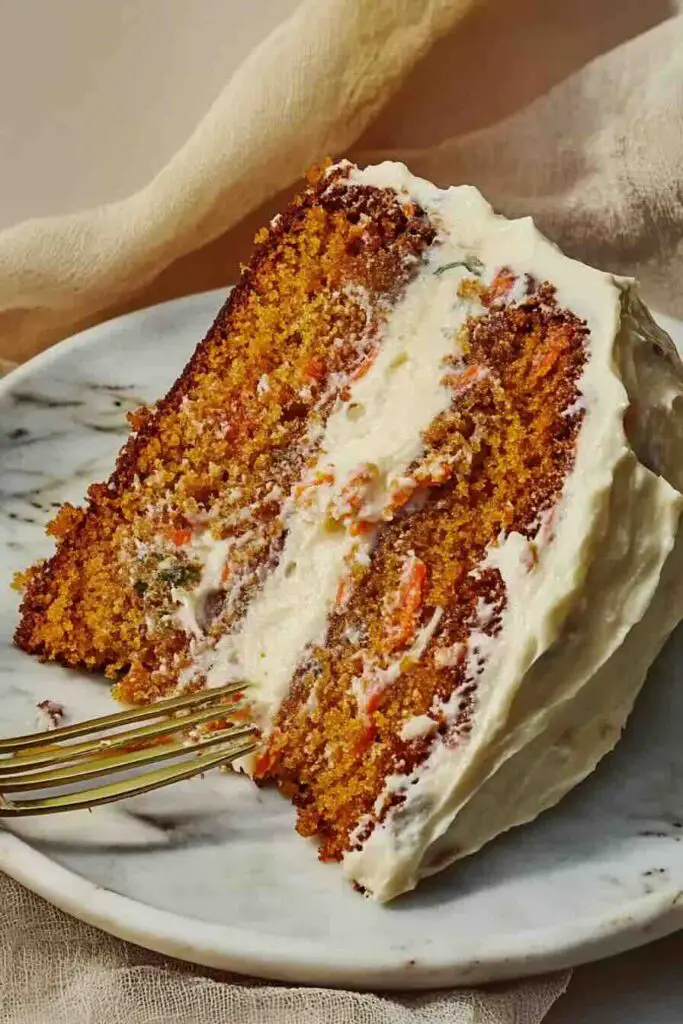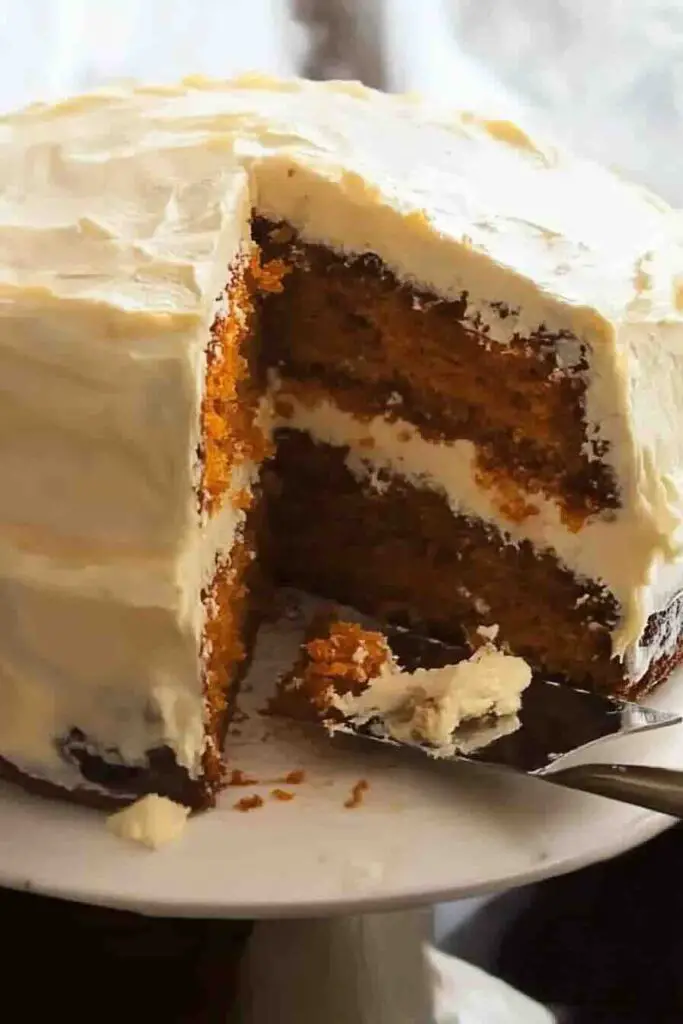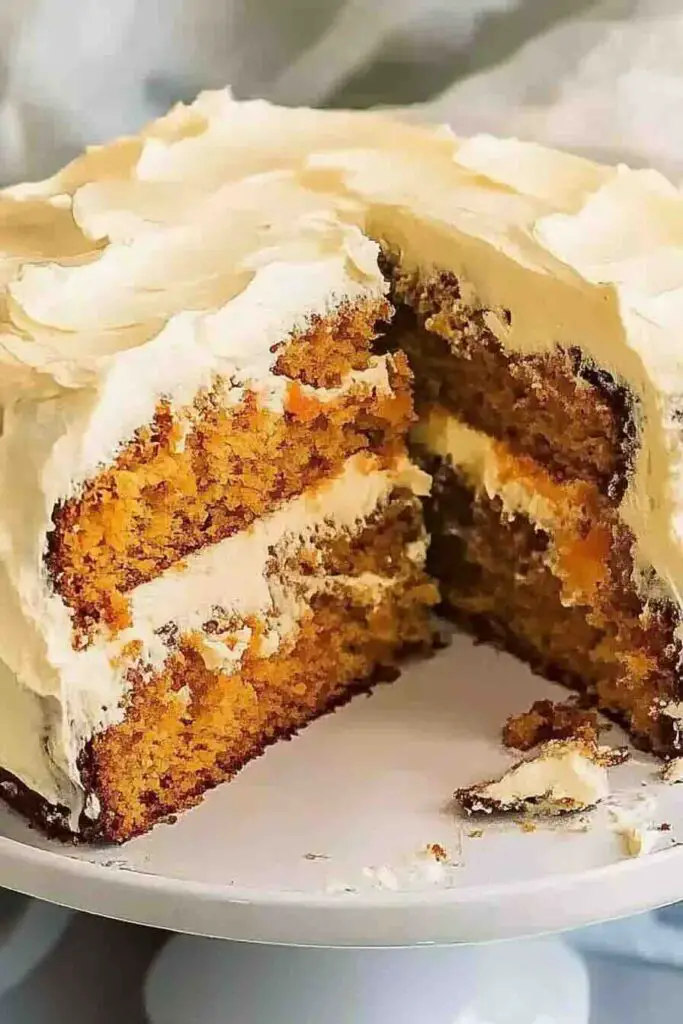Introduction
Let’s talk about carrot cake. Not just any carrot cake—the kind that makes you close your eyes with the first bite because it’s so ridiculously good. You know the one: ultra-moist, perfectly spiced, with a rich, velvety cream cheese frosting that you could eat by the spoonful. That’s what we’re making today!
I still remember the first time I had homemade carrot cake. It wasn’t one of those dry, sad, flavorless cakes that you politely nibble at just to be polite. Oh no. This was something else entirely. My friend’s grandmother baked it, and I swear, I still dream about it. The warmth of cinnamon, the crunch of walnuts, and the way the sweet, earthy carrots just melted into the batter—it was pure perfection. Ever since, I’ve been on a mission to create a recipe that hits all the right notes, and let me tell you, I nailed it.
So if you’re ready to make the best carrot cake of your life, stick with me. It’s easier than you think, and I promise, once you try it, there’s no going back!

Why You’ll Love This Recipe
- Perfectly Moist – No one likes dry cake. This one stays soft and tender for days!
- Not Too Sweet – Just the right balance of sugar and spice.
- Incredible Texture – A little crunch from the nuts, a bit of chew from the coconut, and that dreamy, smooth frosting.
- Foolproof – No fancy techniques required, just mix and bake.
- Crowd-Pleaser – Even people who “don’t like carrot cake” will devour this.
What Makes a Good Carrot Cake?
Moisture is Everything
A dry carrot cake is a tragedy. The secret? A mix of oil, eggs, and pineapple. Butter is fantastic in many cakes, but here, oil wins. It keeps everything tender and moist without weighing it down. Plus, pineapple adds natural sweetness and an extra boost of moisture.
Texture: The Right Add-Ins
Grated carrots are the star, but let’s talk about the supporting cast. Chopped walnuts? Yes, please. Shredded coconut? A game-changer. Crushed pineapple? Absolutely. Each ingredient adds depth, balancing the softness of the cake with little bursts of flavor.
Frosting: The Grand Finale
Sure, you could use another type of frosting, but why would you? Cream cheese frosting and carrot cake belong together. The tanginess cuts through the sweetness, making every bite absolute perfection.
The Cultural Significance of Carrot Cake
Carrot Cake Around the World
Believe it or not, carrot-based desserts date back centuries. People used carrots as a natural sweetener long before refined sugar was widely available. From medieval Europe’s carrot puddings to today’s decadent layer cakes, this dessert has serious history!
A Classic with Staying Power
Why does carrot cake remain a favorite? Simple—it’s comforting, slightly nostalgic, and always delivers on flavor. You’ll find it everywhere from fancy bakeries to grandma’s kitchen, and for good reason.
History of Carrot Cake
Medieval Origins
Back in the day, sugar was expensive. Carrots, on the other hand, were abundant and naturally sweet. People started using them in puddings and baked goods, laying the groundwork for the carrot cake we know and love today.
The Rise of Carrot Cake in the 20th Century
Fast forward a few centuries, and carrot cake really hit its stride. It became wildly popular during WWII, when sugar rationing made carrots an attractive alternative. By the 1960s, it had fully evolved into the rich, frosted cake we adore today.
Ingredients
The Essentials
- Carrots – Freshly grated. No pre-shredded stuff; they’re too dry!
- Flour – All-purpose works best.
- Eggs – Adds structure and richness.
- Oil – Keeps the cake moist.
- Sugar – A mix of brown and white sugar for depth.
- Spices – Cinnamon, nutmeg, and a pinch of ginger.
- Baking Soda & Baking Powder – The magic that makes it rise.
- Crushed Pineapple – Adds sweetness and moisture.
- Walnuts & Coconut – Optional, but highly recommended.
The Frosting
- Cream Cheese – Full-fat, because flavor matters.
- Butter – Softened for smoothness.
- Powdered Sugar – Just enough for the perfect sweetness.
- Vanilla Extract – For that extra touch of flavor.
Equipment Needed
- Mixing Bowls – One for wet ingredients, one for dry.
- Box Grater – For those fresh, juicy carrots.
- Cake Pans – Two round pans or a single sheet pan.
- Hand Mixer or Stand Mixer – For a silky frosting.
How to Make Carrot Cake
Step 1: Prep Your Ingredients
Grate the carrots, drain the pineapple, and toast the nuts if you’re using them.
Step 2: Mix the Dry Ingredients
In a bowl, whisk together the flour, sugar, spices, baking powder, and baking soda.
Step 3: Mix the Wet Ingredients
In another bowl, beat the eggs, oil, vanilla, and pineapple juice until well combined.
Step 4: Combine Everything
Gently fold the dry ingredients into the wet mixture. Stir in the carrots, nuts, and coconut.
Step 5: Bake
Divide the batter between greased cake pans and bake at 350°F (180°C) for 35-40 minutes.
Step 6: Make the Frosting
Beat the cream cheese, butter, and vanilla until smooth. Gradually add powdered sugar.
Step 7: Assemble and Frost
Once the cakes are completely cool, spread a thick layer of frosting between the layers and over the top.

How to Tell When Carrot Cake is Done
Baking carrot cake to perfection is all about timing, texture, and a little bit of patience. While following the recommended bake time is a good start, ovens can be unpredictable, and factors like pan size, altitude, and ingredient moisture levels can affect how long your cake needs. So, how do you know when your carrot cake is ready?
Visual Cues
One of the easiest ways to tell if your carrot cake is done is simply by looking at it. The top should have a rich golden-brown color, and the edges should start pulling away from the sides of the pan. If you notice that the middle still looks wet or overly shiny, it probably needs a few more minutes in the oven.
The Toothpick Test
This is the go-to method for checking cake doneness. Take a clean toothpick or a thin skewer and insert it into the center of the cake. If it comes out with a few moist crumbs, you’re good to go! However, if there’s still wet batter sticking to it, the cake needs more time. On the flip side, if the toothpick comes out bone dry, your cake may be slightly overbaked—but don’t worry, the frosting will help compensate!
Touch and Spring-Back Test
Gently press down on the center of the cake with your fingertip. If it bounces back immediately, it’s done. If it stays indented or feels too soft, let it bake a bit longer. This method works best when combined with the visual and toothpick tests for ultimate accuracy.
Let It Rest
Even after removing your cake from the oven, it continues to cook slightly due to residual heat. Allow it to sit in the pan for about 10 minutes before transferring it to a wire rack to cool completely. This helps set the structure and prevents the cake from breaking apart when removed from the pan.
Variations & Toppings
Carrot cake is wonderfully versatile, allowing you to customize it to your taste while keeping its signature moistness and spice profile. Whether you prefer a classic version or want to experiment with new flavors, there are plenty of ways to make this cake your own.
Flavor Variations
- Spiced Carrot Cake: If you love warm, aromatic flavors, add nutmeg, cloves, or even a hint of cardamom to the batter. These spices complement the cinnamon beautifully and enhance the cake’s overall depth.
- Tropical Carrot Cake: For a bright, fruity twist, add extra crushed pineapple and a handful of shredded coconut to the mix. You can even swap out some of the oil for coconut oil to amplify the flavor.
- Chocolate Carrot Cake: Love chocolate? Mix in a couple of tablespoons of cocoa powder and a handful of dark chocolate chips for a rich, decadent variation. The chocolate blends surprisingly well with the spices and carrots!
- Nut-Free Carrot Cake: If you’re not a fan of nuts or have an allergy, simply leave them out. You won’t need to make any other adjustments, and the cake will still be just as delicious.
Topping Ideas
While classic cream cheese frosting is the go-to for carrot cake, you can take things up a notch with creative toppings and garnishes. Here are some ideas:
- Toasted Coconut Flakes: Adds a slight crunch and a tropical touch.
- Candied Carrot Strips: Thinly sliced carrots cooked in sugar syrup until glossy make a stunning decoration.
- Chopped Walnuts or Pecans: For extra texture and a hint of buttery nuttiness.
- Cinnamon Sugar Dusting: A simple but effective way to boost the warm spice flavors.
- Caramel Drizzle: A little drizzle of homemade caramel sauce makes every bite even more indulgent.
Nutritional Insights
Carrot cake is often perceived as a healthier dessert because, well, it has carrots! While it does contain some nutritious ingredients, it’s still a rich, sweet treat. Here’s a breakdown of what’s really in each slice.
Caloric Breakdown
A standard slice of carrot cake (with frosting) contains approximately:
- Calories: ~709 kcal
- Carbohydrates: 92g
- Fat: 37g
- Protein: 7g
Most of the calories come from sugar and oil, making this a more indulgent dessert. However, it does offer some nutritional benefits thanks to its key ingredients.
Healthier Swaps
- Reduce the Sugar: You can cut down on sugar slightly without sacrificing flavor. Try using a mix of honey and brown sugar for a more natural sweetness.
- Use Greek Yogurt: Swapping out some of the oil for Greek yogurt reduces fat while keeping the cake moist.
- Go Whole Wheat: Using whole wheat flour instead of all-purpose adds fiber and nutrients, though the cake may be slightly denser.
- Lighten Up the Frosting: If you love cream cheese frosting but want a lighter version, use less butter and replace some of the powdered sugar with a drizzle of maple syrup or honey.
Pro Tips & Tricks
Carrot cake is fairly simple to make, but a few expert tricks can take it from good to extraordinary.
The Best Texture
- Always use freshly grated carrots instead of pre-shredded ones. Packaged shredded carrots are often too dry and don’t blend into the batter as well.
- Don’t overmix the batter once you combine the wet and dry ingredients. Overmixing can lead to a dense, tough cake.
- Sift the dry ingredients before adding them to the wet mixture. This helps ensure even distribution of baking soda and spices.
Fluffy Frosting
- Make sure your cream cheese and butter are softened before beating. Cold ingredients won’t blend as smoothly, leading to lumps.
- Beat the frosting for a full 3-5 minutes to achieve an ultra-light, airy texture.
- If the frosting is too soft, chill it for 10-15 minutes before spreading it on the cake.
Cake Layers
- Use a kitchen scale to divide the batter evenly between pans. This ensures the layers bake at the same rate.
- Once baked, flip the cakes upside down before frosting. This helps create a flat, even surface for a professional-looking finish.
Storage & Health Tips
How to Store Carrot Cake
Carrot cake stays moist for days, but proper storage is key to keeping it fresh.
- Room Temperature: If unfrosted, carrot cake can be stored in an airtight container at room temperature for up to 2 days.
- Refrigerator: Since cream cheese frosting is perishable, a frosted carrot cake should be stored in the fridge. Keep it in an airtight container to prevent it from drying out, and it will stay fresh for up to 5 days.
- Freezer: Carrot cake freezes beautifully! Wrap individual slices tightly in plastic wrap, place them in a freezer-safe container, and store for up to 3 months. Thaw in the fridge overnight before serving.
Best Ways to Reheat Carrot Cake
- If refrigerated, let the cake sit at room temperature for about 30 minutes before serving. This allows the flavors and frosting to soften.
- For a warm slice, microwave it for 10-15 seconds—just enough to make it taste like it’s freshly baked!

FAQs
Why is it called carrot cake?
Carrot cake gets its name because, well, it’s packed with carrots! But historically, carrots were used in desserts as a natural sweetener when sugar was scarce.
Can I make this without nuts?
Absolutely! Just omit the walnuts or pecans, and your cake will still be moist and flavorful.
Is carrot cake healthier than other cakes?
While it does contain carrots and nuts, carrot cake is still high in sugar and fat. However, with a few ingredient swaps, you can make a lighter version without compromising flavor.
Can I make carrot cake ahead of time?
Yes! In fact, carrot cake often tastes even better the next day as the flavors meld. Just store it properly to maintain freshness.
Before You Go…
Craving more goodness? Check out my recipe for Chocolate Brownies next. It’s just as comforting, indulgent, and easy to make. You’re going to love it! ❤️
Don’t forget to subscribe for more mouthwatering recipes straight to your inbox!

Carrot Cake Recipe
- Prep Time: 20 minutes
- Cook Time: 40 minutes
- Total Time: 1 hour
- Yield: 12 servings 1x
Description
This homemade carrot cake is incredibly moist, packed with warm spices, and topped with a luscious cream cheese frosting. With freshly grated carrots, crunchy walnuts, and a hint of cinnamon, this cake is a timeless favorite. Perfect for birthdays, holidays, or any occasion, this easy-to-follow recipe guarantees a soft, flavorful cake every time!
Ingredients
For the Cake:
- 2 cups (250g) all-purpose flour
- 2 tsp baking soda
- 1 tsp baking powder
- ½ tsp salt
- 1 ½ tsp cinnamon
- ½ tsp nutmeg (optional)
- 1 cup (200g) granulated sugar
- 1 cup (200g) brown sugar
- 1 cup (240ml) vegetable oil
- 4 large eggs
- 2 tsp vanilla extract
- 2 cups (250g) grated carrots
- ½ cup (120ml) crushed pineapple (drained)
- ¾ cup (90g) chopped walnuts or pecans (optional)
- ½ cup (40g) shredded coconut (optional)
For the Cream Cheese Frosting:
- 8 oz (226g) cream cheese, softened
- ½ cup (115g) unsalted butter, softened
- 2 ½ cups (300g) powdered sugar
- 1 tsp vanilla extract
- 1–2 tbsp heavy cream (if needed, for consistency)
Instructions
- Preheat & Prep: Preheat your oven to 350°F (175°C). Grease and line two 9-inch round cake pans with parchment paper.
- Mix Dry Ingredients: In a large bowl, whisk together flour, baking soda, baking powder, salt, cinnamon, and nutmeg.
- Mix Wet Ingredients: In another bowl, beat together granulated sugar, brown sugar, vegetable oil, eggs, and vanilla extract until smooth.
- Combine Ingredients: Gradually add the dry mixture to the wet mixture, stirring until just combined. Fold in grated carrots, crushed pineapple, walnuts, and coconut.
- Bake the Cake: Divide the batter evenly between the cake pans. Bake for 35–40 minutes or until a toothpick inserted into the center comes out clean.
- Cool Completely: Allow the cakes to cool in the pans for 10 minutes before transferring them to a wire rack to cool completely.
- Make the Frosting: Beat the cream cheese and butter together until creamy. Gradually add powdered sugar, vanilla extract, and heavy cream (if needed) until smooth and fluffy.
- Assemble & Frost: Spread frosting between the cake layers and over the top and sides. Decorate with extra nuts or shredded coconut if desired.
- Serve & Enjoy: Slice, serve, and enjoy this moist, flavorful carrot cake!
Notes
- For extra moistness, do not overmix the batter.
- Freshly grated carrots work best; avoid using pre-shredded carrots.
- Store leftover cake in an airtight container in the fridge for up to 5 days.
- This cake can be frozen for up to 3 months—just thaw before serving.
Nutrition
- Calories: 709
- Sugar: 65g
- Sodium: 320mg
- Fat: 37g
- Saturated Fat: 10g
- Carbohydrates: 92g
- Fiber: 2g
- Protein: 7g
- Cholesterol: 70mg
